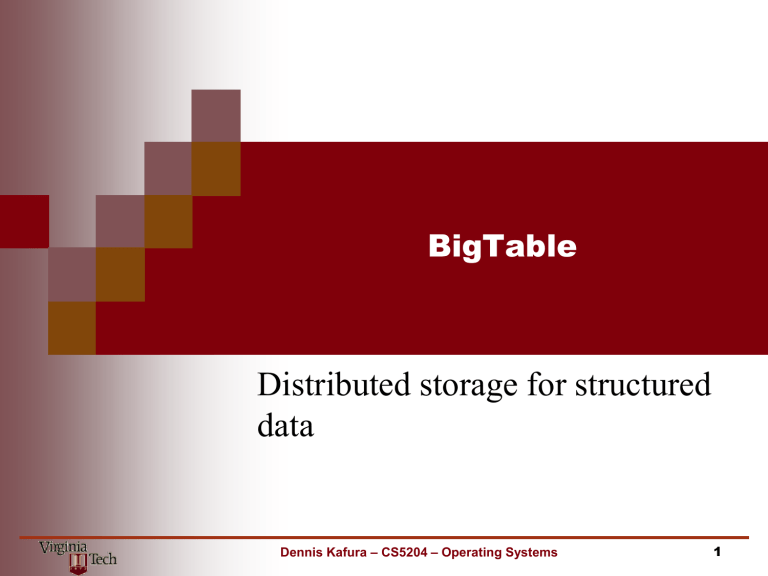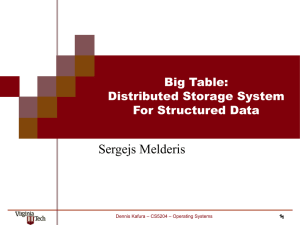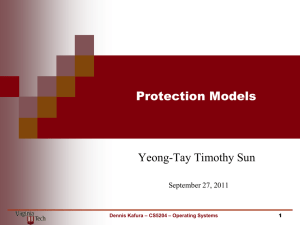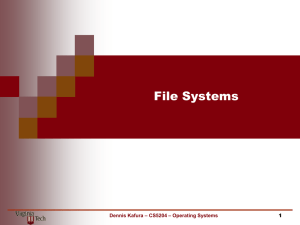PPT

BigTable
Distributed storage for structured data
Dennis Kafura
– CS5204 – Operating Systems 1
BigTable
Overview
Goals
scalability
petabytes of data
thousands of machines applicability
to Google applications
Google Analytics
Google Earth
…
not a general storage model high performance high availability
Structure
uses GFS for storage
uses Chubby for coordination Note: figure from presentation by Jeff Dean (Google)
Dennis Kafura
– CS5204 – Operating Systems 2
Data Model
(row: string, column: string, timestamp: int64) string
BigTable
Row keys
up to 64K, 10-100 bytes typical lexicographically ordered
reading adjacent row ranges efficient organized into tablets: row ranges
Column keys
grouped into column families - family:qualifier
column family is basis for access control
Dennis Kafura
– CS5204 – Operating Systems 3
Data Model
(row: string, column: string, timestamp: int64) string
BigTable
Timestamps
automatically assigned (real-time) or application defined used in garbage collection (last n, n most recent, since time)
Transactions
iterator-style interface for read operation
atomic single-row updates no support for multi-row updates no general relational model
Dennis Kafura
– CS5204 – Operating Systems 4
BigTable
Table implementation
...
k
...
v f g a
...
...
z table v
...
z g
...
k f a
...
tablet tablet tablet
a table is divided into a set of tablets, each storing a set of consecutive rows tablets typically 100-200MB
Dennis Kafura
– CS5204 – Operating Systems 5
BigTable
Table implementation g
...
k tablet
SSTable SSTable
. . .
SSTable
SSTable
64K
Block
64K
Block
...
64K
Block index
a tablet is stored as a set of
SSTables an SSTable has a set of 64K blocks and an index each SSTable is a GFS file
Dennis Kafura
– CS5204 – Operating Systems 6
metadata table
Locating a tablet
BigTable
metadata table stores location information for user table metadata table index by row key: (table id, end row) root tablet of metadata table stores location of other metadata tablets location of root tablet stored as a Chubby file metadata consists of
list of SSTables redo points in commit logs
Dennis Kafura
– CS5204 – Operating Systems 7
BigTable
Master/Servers
Multiple tablet servers
Performs read/write operations on set of tables assigned by the master
Each creates, acquires lock on uniquely named file in a specific (Chubby) directory
Server is alive as long as it holds lock
Server aborts if file ceases to exist
Single master
Assigns tablets to servers
Maintains awareness (liveness) of servers
List of servers in specific (servers) directory
Periodically queries liveness of table server
If unable to verify liveness of server, master attempts to acquire lock on server’s file
If successful, delete server’s file
Dennis Kafura
– CS5204 – Operating Systems 8
BigTable
Write Op memtable
Tablet operations
Read Op
Memory
GFS tablet (commit) log SSTable SSTable SSTable
Updates are written in a memory table after being recorded in a log
Reads combine information in the memtable with that in the SSTables
Dennis Kafura
– CS5204 – Operating Systems 9
BigTable
Minor compaction new memtable old memtable
Memory
GFS tablet (commit) log SSTable SSTable SSTable SSTable
Triggered when memtable reaches a threshold
Reduces memory footprint
Reduces data read from commit log on recovery from failure
Read/write operations continue during compaction
Dennis Kafura
– CS5204 – Operating Systems 10
BigTable
Merging compaction new memtable tablet (commit) log old memtable
SSTable SSTable SSTable SSTable
Memory
GFS
SSTable
Compacts existing memtable and some number of SSTables into a single new SSTable
Used to control number of SSTables that must be scanned to perform operations
Old memtable and SSTables are discarded at end of compaction
Dennis Kafura
– CS5204 – Operating Systems 11
BigTable
Major compaction new memtable old memtable tablet (commit) log SSTable SSTable SSTable SSTable
Memory
GFS
SSTable
Compacts existing memtable and all SSTables into a single SSTable
Dennis Kafura
– CS5204 – Operating Systems 12
Refinements
Locality groups
Client defines group as one or more column families
Separate SSTable created for group
Anticipates locality of reading with a group and less across groups
Compression
Optionally applied to locality group
Fast: 100-200MB/s (encode), 400-1000MB/s (decode)
Effective: 10-1 reduction in space
Caching
Scan Cache:
key-value pairs held by tablet server
Improves re-reading of data
Block Cache:
SSTable blocks read from GFS
Improves reading of “nearby” data
Bloom filters
Determines if an SSTable might contain relevant data
BigTable
Dennis Kafura
– CS5204 – Operating Systems 13
Performance
BigTable
Random reads slow because tablet server channel to GFS saturated
Random reads (mem) is fast because only memtable involved
Random & sequential writes > sequential reads because only log and memtable involved
Sequential read > random read because of block caching
Scans even faster because tablet server can return more data per RPC
Dennis Kafura
– CS5204 – Operating Systems 14
Performance
BigTable
Scalability of operations markedly different
Random reads (mem) had increase of ~300x for an increase of 500x in tablet servers
Random reads has poor scalability
Dennis Kafura
– CS5204 – Operating Systems 15
BigTable
Lessons Learned
Large, distributed systems are subject to many types of failures
Expected: network partition, fail-stop
Also: memory/network corruption, large clock skew, hung machines, extended and asymmetric network partitions, bugs in other systems (e.g., Chubby), overflow of GFS quotas, planned/unplanned hardware maintenance
System monitoring important
Allowed a number of problems to be detected and fixed
Dennis Kafura
– CS5204 – Operating Systems 16
BigTable
Lessons Learned
Delay adding features unless there is a good sense of their being needed
No general transaction support, not needed
Additional capability provided by specialized rather than general purpose mechanisms
Simple designs valuable
Abandoned complex protocol in favor of simpler protocol depending on widely-used features
Dennis Kafura
– CS5204 – Operating Systems 17









